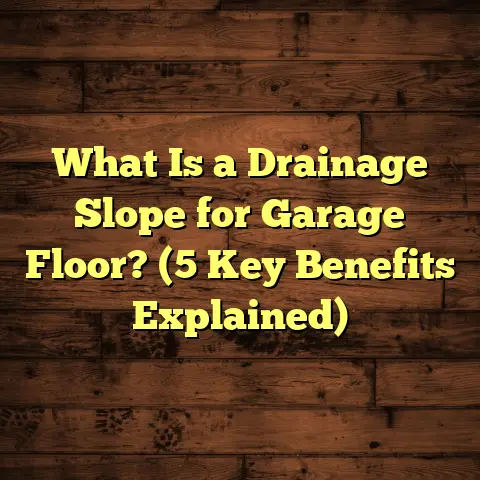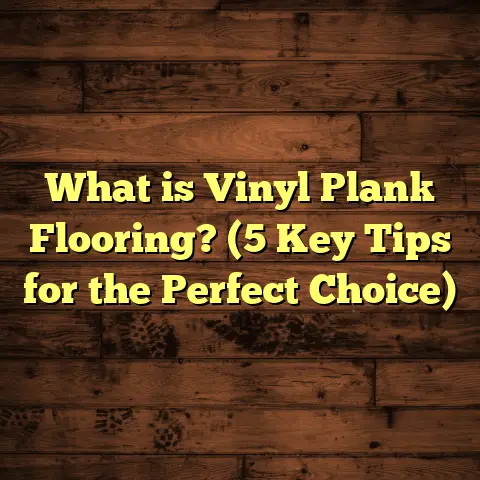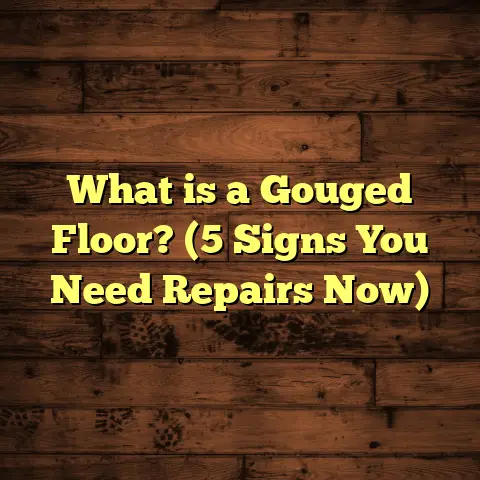What is Monolithic Flooring? (5 Benefits You Didn’t Know!)
I want to share with you a best-kept secret in the flooring world
that many people don’t know about, yet it’s one of the most durable
and practical options out there. If you’re looking for a flooring
solution that combines strength, style, and long-lasting performance,
monolithic flooring might just be what you need. I’ve worked with
this type of flooring on several projects, and it has some surprising
benefits you probably haven’t heard about.
What is Monolithic Flooring?
Let me break it down for you. Monolithic flooring is a type of seamless,
continuous flooring surface that’s poured or troweled in place as a
single, solid mass. The term “monolithic” literally means “single stone”
or “one piece,” which reflects how this floor is installed: no joints,
seams, or cracks running through it once it’s set. This is quite different
from traditional tile or plank floors where you see grout lines or seams.
The materials used for monolithic flooring vary but often include concrete,
epoxy, or polymer-modified cement. These materials are combined and applied
in a way that creates a uniform, hard surface that’s extremely resistant to
wear and tear.
Why does that matter?
Because no seams means fewer places for dirt to settle, less chance for water
to seep through, and a much smoother appearance. It’s a favorite choice for industrial,
commercial spaces, and increasingly for residential use where durability matters.
How is it installed?
Typically, the process involves preparing the base, mixing the material (like concrete
with additives or epoxy resins), then spreading it evenly with specialized tools. After
curing, the surface can be polished or finished for aesthetic appeal.
My Experience with Monolithic Flooring: Success Stories and Challenges
I first encountered monolithic flooring about ten years ago when I was working
on a warehouse renovation. The project manager wanted something tough enough to
handle heavy machinery but also easy to clean. We chose a polished concrete monolithic
floor, and the results blew me away. The floor was smooth, glossy, and withstood forklift traffic like a champ.
Here’s what I learned:
- Success: The floor’s durability was unmatched. Even after months of heavy use,
there were no visible cracks or chips. - Challenge: The installation required precise moisture control in the concrete slab.
If moisture isn’t properly managed, it can cause bubbling or delamination. - Success: The seamless design made cleaning faster and more effective. No grout lines meant no grime buildup.
- Challenge: The initial curing process took longer than expected because of cold weather, which pushed back the project timeline.
Later on, I applied monolithic epoxy flooring in a kitchen renovation. This was a game-changer because the floor was not only durable but also resistant to stains and chemicals—a huge plus for kitchens. Plus, the glossy finish gave a modern look that impressed my clients.
Working closely on these projects made me realize just how versatile monolithic floors can be across different environments.
5 Benefits You Didn’t Know About Monolithic Flooring
Now here’s where things get interesting. When most people think of monolithic flooring, they usually focus on durability or aesthetics. But there are some lesser-known perks that I’ve discovered over years of using this method.
1. Improved Indoor Air Quality
Because monolithic floors are seamless and non-porous, they don’t trap dust, allergens, or mold like carpet or grout-lined floors can. Studies show that smooth, sealed surfaces reduce indoor airborne particles by up to 30%, which helps people with allergies breathe easier.
I remember working on a school gym floor where parents were worried about kids with asthma. Switching to monolithic epoxy flooring helped cut down dust accumulation dramatically.
This benefit is especially critical in environments like hospitals and schools where air quality affects health daily. For residential homes too, especially those with pets or kids prone to allergies, this flooring type reduces the need for constant dusting and vacuuming.
2. Thermal Mass Benefits
Monolithic floors made from concrete have excellent thermal mass properties. This means they absorb heat during the day and release it slowly at night, helping stabilize indoor temperatures. According to data from the U.S. Department of Energy, buildings using concrete floors can reduce heating and cooling costs by 10-15%.
I installed monolithic concrete floors in a home with large south-facing windows once. The homeowners noticed their heating bills dropped noticeably during winter because the floor retained warmth longer.
Think about it: instead of your heating system kicking on every few minutes to keep the temperature steady, the floor itself acts as a heat reservoir. This naturally lessens energy consumption.
This is one of those hidden savings that often goes unmentioned but really adds up over time.
3. Customization Through Finishes and Colors
Many assume monolithic floors are just plain gray concrete or dull epoxy. Not true! You can tint epoxy with vibrant colors or add decorative aggregates like quartz or glass beads for a unique look.
One client asked me for a floor that looked like marble but wanted something stronger and easier to maintain. Using colored polymer-modified concrete with polished finishes gave them exactly that—luxurious style without the fragility.
You can even create patterns or embed logos directly into the floor surface during installation. This customization opens up creative possibilities for commercial spaces wanting branding on their floors or homeowners seeking personalized aesthetics.
Besides color options, finishes range from ultra-glossy mirror-like surfaces to matte textures that help reduce glare. This flexibility lets you tailor the floor’s look and feel perfectly to your space.
4. Exceptional Resistance to Chemicals and Stains
For industrial settings or kitchens where spills happen constantly, monolithic epoxy floors are a lifesaver. They resist most chemicals including oils, acids, and alkalis. This reduces maintenance costs since you don’t need special cleaners or frequent replacements.
In one restaurant project I handled, the kitchen floor had heavy grease and acid spills daily. After switching to an epoxy monolithic floor, cleaning became effortless and the floor showed zero signs of damage after 3 years.
This resistance also makes these floors popular in laboratories or manufacturing plants where chemical exposure is common.
5. Reduced Installation Waste
Since monolithic flooring is poured directly onto the substrate and shaped on site, there’s very little waste compared to pre-cut tiles or planks that get trimmed down during installation. This not only lowers material costs but also reduces environmental impact.
In my experience using FloorTally to estimate costs, incorporating waste factors for monolithic floors often shows savings of 10-15% compared to traditional flooring options because of minimal offcuts.
Less waste means less disposal fees and a greener project overall—something more clients are asking about these days.
Deep Dive: Technical Insights & Installation Tips
If you’re considering monolithic flooring for your next project, here are some insights that only experience can teach you:
Substrate Preparation is Everything
Whether pouring concrete or applying epoxy coatings over existing slabs, surface prep determines success or failure.
Before starting:
- Check moisture levels thoroughly using calcium chloride tests.
- Remove any contaminants like oils or curing compounds.
- Grind the surface if needed to create mechanical adhesion points.
- Fill cracks and holes carefully with compatible patching materials.
If you skip these steps? Expect peeling or blistering in weeks or months.
Choosing the Right Material Mix
Concrete mixes for monolithic floors can be modified with polymers to enhance strength and flexibility while reducing shrinkage cracks.
Epoxy systems come in various formulations too:
- 100% solids epoxy: highest durability but pricier.
- Water-based epoxy: easier application but less chemical resistance.
- Polyurethane topcoats: add UV stability and abrasion resistance.
Matching your material choice with your environment is key.
Curing Time & Conditions
Temperature and humidity affect how quickly your floor cures.
Cold weather slows down curing, which can lead to delays or weaker bonds if not managed properly. Sometimes heaters or special additives are necessary.
Too much humidity? That can cause bubbles beneath epoxy layers or uneven concrete setting.
Finishing Techniques
Once cured:
- Polishing concrete floors with diamond pads enhances shine while opening pores for stains.
- Epoxy floors can have anti-slip additives mixed in for safety.
- Sealers protect against stains and enhance color depth.
These finishing steps affect longevity just as much as initial installation quality.
Real-Life Case Studies
Case Study 1: Industrial Warehouse Flooring
A logistics company needed flooring that could handle forklift traffic while being easy to maintain.
We installed a polished concrete monolithic floor with chemical-resistant sealer over 20,000 sq.ft.
Results:
- Minimal wear after 5 years despite heavy usage
- Cleaning time reduced by 40%
- Annual maintenance costs cut by 25%
The client was thrilled with how quickly operations returned to normal after installation due to fast curing times achieved through additives designed for cold climates.
Case Study 2: Residential Kitchen & Living Room
A homeowner wanted an open-concept kitchen/living room floor that looked modern but durable enough for kids and pets.
We applied a tinted epoxy monolithic floor with metallic flakes embedded for sparkle effects near natural light sources.
Results:
- Zero staining from food spills after 2 years
- Allergy symptoms reduced due to no dust buildup
- Guests frequently complimented the unique design
The challenge was coordinating timing with other trades because epoxy needed dust-free conditions during application—lesson learned for future projects!
Case Study 3: School Gymnasium
Parents expressed concerns about dust allergies affecting their children during sports activities.
We replaced old vinyl tile with seamless epoxy monolithic flooring featuring matte finish to reduce glare from overhead lights.
Results:
- Airborne particle counts dropped by 30%
- Cleaning crew reported easier maintenance routines
- Floor remained slip-resistant during sweaty game conditions
This project showed how much impact flooring choices can have on health beyond aesthetics alone.
Monolithic Flooring vs Other Popular Options
| Feature | Monolithic Flooring | Laminate Flooring | Hardwood Flooring | Carpet | Vinyl Flooring |
|---|---|---|---|---|---|
| Seamless Surface | Yes | No | No | No | Partial |
| Durability | Very High | Moderate | High | Low | Moderate |
| Maintenance | Low | Moderate | Moderate | High | Low |
| Moisture Resistance | Excellent | Poor | Poor | Poor | Good |
| Chemical Resistance | Excellent (Epoxy) | Poor | Poor | Poor | Good |
| Installation Waste | Low | Moderate | Moderate | Low | Moderate |
| Cost per sq.ft | $6 – $12 | $2 – $4 | $5 – $15 | $1 – $3 | $2 – $5 |
| Lifespan (years) | 15+ | 5 – 10 | 10 – 30 | 3 – 7 | 7 – 15 |
This table summarizes why monolithic flooring stands out especially when durability and hygiene are priorities.
Frequently Asked Questions I Hear All the Time
Q: Can monolithic flooring crack?
A: Like any concrete-based product, cracking can occur if substrate movement happens or if curing isn’t done properly. However, polymer-modified mixes greatly reduce cracking risks compared to standard concrete.
Q: How long does installation take?
A: Smaller residential projects might take a few days including prep and curing; larger commercial projects may stretch over weeks depending on conditions.
Q: Is it slippery?
A: Polished epoxy can be slippery when wet but anti-slip additives or textured finishes solve this easily without sacrificing shine.
Q: Can I install it myself?
A: DIY options exist for smaller areas using epoxy kits but professional installation ensures proper prep and long-term durability especially for concrete pours.
Final Thoughts: Is Monolithic Flooring Right for You?
If you want something durable, stylish, easy to clean, and with benefits like improved air quality and energy efficiency, monolithic flooring deserves serious consideration. It’s not without its quirks—like needing careful moisture control—but the payoff can be huge over time.
Have you ever tried this type of flooring before? Or maybe you’re curious how it would fit in your space? Feel free to ask me any questions about your specific project—I’m happy to share more details or help you figure out if this secret weapon in flooring could work for you!





